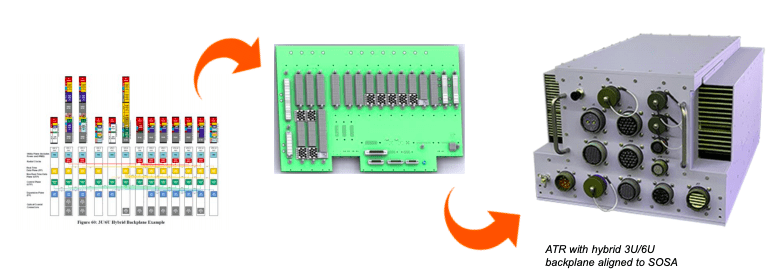
The SOSA Technical Standards are being updated in advance of their release next year. (Elma Electronics)
Sensor Open Systems Architecture (SOSA) technical standards, a common backbone architecture for sensors on embedded systems, are evolving as the consortium behind their development gets closer to starting its certification process. During a Dec. 3 webinar, experts from Elma Electronic, Pentek, and Kontron discussed the changes that have been made to SOSA and the status of the certification process which could be up and running by next summer.
There are two key documents that will help define the SOSA Conformance Certification Process: the Conformance Policy, which will outline the policies and process of the SOSA Conformance Certification Program, and the Conformance Certification Guide, which will help suppliers who want to certify products within the program.
The Conformance Policy will be published early next year with the Conformance Guide coming in the second quarter of 2021, Mark Littlefield, vertical product manager for defense at Kontron, said. Revision 1.0 will then be publicly released in May with the certification program starting shortly after.
“Acquisition authorities like the US government and the Defense Department are going to specify that they want SOSA conformant product for their systems for some systems, not every defense system out there is going to want this but there are some that’s going to,” Littlefield said. “They want some assurance that the components that are being chosen for that system in fact meet the standard.”
SOSA is one of four open system standards that was mentioned in association with the Modular Open Systems Approach (MOSA) memorandum signed by Air Force, Army and Navy officials in January 2019. The standard uses VITA’s OpenVPX architecture to allow the design and implementation of high-speed, high-power switched fabric-based systems that are capable of integrating single board computers into sensor platforms.
What that could mean for flight control systems in the future is the easier introduction of new capabilities that only require the slotting in and out of cards with new capabilities on existing systems, rather than the type of massive re-wiring and hardware replacement that typically takes years to complete across defense aircraft programs.
The certification process will involve a third party verification authority who will check the sensor component for approved criteria, Littlefield said. The certification will last for three years and can be renewed after. Littlefield said the cost has not been defined yet.
However, before the Conformance Policy is published the technical standards are still being updated with new requirements.
The use of refined slot profiles will now be required in SOSA, Ken Grob, director of embedded computing architectures at Elma Electronic, said during the webinar. They must support the commonly used slot profiles in SOSA: primary payload, secondary payload, central switch, timing slot, and I/O intensive SBC.

The SOSA Technical Standards have updated backplane and slot requirements. (Elma Electronics)
The backplane, which is needed to receive and interconnect SOSA Plug-In Cards (PIC) and power supplies, will need to be updated to support 25 Gb/s of ethernet instead of 10 and have 3U and 6U Plug-Ins instead of only 3U, according to Grob.
“What happened is as the speeds increase that needed to be supported relative to the interconnect and protocols,” Grob said. “This is because of the bandwidth needs for the applications.”
The standards will require a new high-density VITA 67 radio frequency (RF) and optical input/output (I/O), Rodger Hosking, vice president of Pentek, Inc., said during the panel. This will eliminate the front panel I/O connections making maintenance easier and improving reliability. The coaxial, optical, and mixed optical RF will also support a growing vendor base and products.

During the webinar, Roger Hosking described changes to VITA 67 radio frequency (RF) and optical I/O in the SOSA Technical Standards. (Pentek)
“The nice thing about this is that it allows a single backplane to be designed by some, let’s say Elma, that then can be reconfigured based on the inserts that go into these apertures to support different kinds of RF and optical IO as required without having to incur the cost of designing a new backboard on a new backplane, to be able to accept that new standard,” Hosking said.
The SOSA technical standards will help increase the effectiveness and cost savings in military aircraft avionics. Because these avionics systems are traditionally a collection of sub-systems, making any changes to them was limited to replacing the entire sub-system, Hosking told Avionics International in an emailed statement.
“SOSA offers significant solutions to this traditional methodology,” Hosking said. “First of all, the internal electronics, software, and packaging must be based on open standard architectures, notably OpenVPX. Upgrading a SOSA system can mean keeping the existing sub-system, but replacing one SOSA-compliant plug-in card with another to add new device technology, higher performance levels, faster computing power, and higher signal and data bandwidths. Secondly, SOSA limits the number of different plug-in card types to a very small sub-set of OpenVPX profiles, enhancing interchangeability across vendors and function. Finally, smaller companies can participate in the SOSA vendor community to offer competitive solutions shortly after new technology components become available.”
By using the SOSA technical standards on technology like an electronic warfare radar countermeasure upgrade to a fighter jet, new innovations are able to keep pace with the continuous advancements in radar technology. Being able to replace a SOSA board with a new board with required capabilities will be a major benefit because it will allow upgrades to be made in far less time, Hosking said.